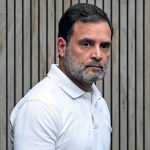Modi 2.0: The Time for Vishwas
With inclusiveness as a new mantra, the Prime Minister’s outreach to minorities will be a new mould of progress and development for all
/wp-content/uploads/2019/06/Modi2.01a.jpg)
HISTORY TELLS US THAT RELIGION can be a liberating force in society. Being secular does not mean judging those who are religious. Being secular means acknowledging the religiosity of fellow humans and working together for a peaceful co-existence… Failure to appreciate religious feelings of ordinary Indians has led to secularism becoming an exclusive club. Worse, it has driven ordinary people into the clutches of vested interests operating in the garb of religion. The rise of the religious right over the last two decades must also be viewed in this context. We must trust the wisdom behind our constitutional ideals on diversity, pluralism, religious freedom and secularism. India is united with all its multiple faith communities unlike some of her neighbours. All political parties need to unequivocally state their commitment to these ideals.”
That was Zakia Soman, well-known activist of the Bharatiya Muslim Mahila Andolan who spearheaded the movement for banning the instant talaq practice in the Muslim community, which resulted in a Central legislation by the Government run by Narendra Modi 1.0. Soman, after the verdict handed on May 23rd, has expressed faith that the Prime Minister would take the entire nation along, based on constitutional ideals.
Echoing others from her community, Soman was not unusual in her confidence. Just two days later, on May 25th, in Parliament’s Central Hall during a crucial 75-minute speech, Modi spelt out his outreach formula for the minorities. Raising the slogan of ‘Sabka Saath, Sabka Vikas, Sabka Vishwas’, he exhorted the 353 new MPs of the BJP-led NDA to draw out minorities from the “bogey of fear” that they had been made victims of for decades, and inspire faith and confidence in them in a nation that progressed together on the back of development, without discrimination against any community. “You should ensure every single Indian is carried along in the development of the country, including those who voted for us with a historic mandate—thus increasing our responsibilities that rest on their immense aspirations—and those who were trenchant critics of our Government,” Modi said.
“Minorities, like the poor, have been deceived and exploited by ruling classes for decades. If they were committed, they should have elevated the socio-educational and economic standards of these communities,” he said. Invoking the 1857 War of Independence against the British in which all communities played their role, he urged that a similar spirit of unification come into play in the country’s development under his Government now.
“The Constitution is supreme for us. Whatever god we worship at home, outside it, Bharat Mata is our God… Those who voted for us are ours and those who did not vote for us are also ours. We do not believe in discrimination,” he said.
“Minorities were kept in illusion, climate of fear and insecurity. They were misled by deceit. It would have been better if they were given education so that some good leaders emerged from the community, which could have become equal to other sections” – May 25, Central Hall, Parliament
In the 17th Lok Sabha, representation of the Muslim community, singled out by Modi for special mention in the context of trust in the new Government, has gone up to 27 from 22 in the previous one. Of BJP’s 303 MPs though, only one, Saumitra Khan from Bishnupur, West Bengal, who joined the party just prior to the elections, is Muslim. At 49, the highest number of MPs from the community in the Lok Sabha was in 1980.
Following the massive mandate handed to Modi for the second time by India, it could not be clearer—unless one has been completely radicalised by liberals on selective ideas—that there has been no concerted discrimination against Muslims in the past five years. Evidence based on field trips by independent researchers throughout Uttar Pradesh and Bihar, two of the biggest states with Muslim populations, shows that the distribution of benefits of various Government schemes, including that of free household gas connections, toilets, power, Mudra loans, etcetera, was a secular exercise with little or no reference to caste or community. Despite poll-time rhetoric, the overwhelming evidence is that people were not discriminated on the basis of caste or community in distribution of benefits, which was based solely on the norms prescribed.
In a recent study, ‘Do Citizens Enforce Accountability For Public Goods Provision?’, Oxford scholar Tanushree Goyal linked election dividends of political parties across 14 states comprising 90 per cent of India’s population and linked the performance of the Pradhan Mantri Gram Sadak Yojana (Prime Minister’s Rural Roads Project) to the results of state and Central elections between 1998 and 2017. A flagship programme of the earlier BJP-led Government headed by Atal Bihari Vajpayee, the PMGSY, launched in 2000, resulted in more than 550,000 km of roads being laid across rural India at a cost of $40 billion, according to the study.
“Who stopped anyone from celebrating Diwali in Ayodhya for all these years? Kumbh Mela was used to malign the tradition of the country by projecting it as a congregation of Naga sadhus. That perception can be changed and it has been changed under the leadership of Yogi Adityanath. And that not only benefited Uttar Pradesh but entire India” – May 27, Varanasi
“My empirical analysis suggests that while the world’s largest rural roads provision programme provided all-weather roads to over 200,000 Indian villages, most of which lacked paved roads and desperately needed all-year market access, the electoral effects of roads provision were close to zero over time, space and electoral levels,” Goyal said in her study.
Modi and party president Amit Shah were aware that eligible youths—‘Google pujaris’—were high on aspirations and would settle for nothing less than second-generation welfare schemes. Hence the carefully tailored benefits that affected their daily lives.
AS PRIME MINISTER, Modi did not get direct political or electoral dividends for this from his critics and opponents, whether in terms of widespread affection, acknowledgement or even the benefit of the doubt on the integrity of his intent on the innumerable schemes designed by his Government to make the lives of the disadvantaged demonstrably better. The call for winning the trust of minorities and pursuing inclusive programmes came despite that. Underestimated by his critics, the schemes established his credentials among the poor.
Modi’s strategy resulted, over the past five years, in giving these targeted beneficiaries of his Government’s schemes basic essentials. More, it gave them crucial intangibles, desperately deserved but deliberately denied dignity. In Varanasi, addressing BJP workers on May 27th, Modi emphasised that the benefits of schemes like housing would reach the eligible who were yet to benefit. To those that the schemes had already benefited, he stressed, “This is not a favour to you, or anyone’s magnanimity. This is your right that you deserved and were denied.”
In the past, the dominant political class perceived its electoral advantage in widening communal divides ensuring that there was little incentive in bridging the rift or restoring communal harmony. Muslim hardliners were also given benefits in the form of political patronage, investing them with little incentive to change the narrative. Ordinary people of the community were left at the mercy of vested interests within, especially ‘vote influencers’ like the clergy. Ordinary folk had little option but to buckle under the exploitation by their ‘leaders’ even as this grew to be an established practice over time.
“It was for the first time this year, that in the 26th January parade, a tableau of Lord Rama—in his different avatars—as interpreted in South Asia was included. But along with this, we should also remember that we are the people who established Atal Tinkering Lab, so that our new generation, students of Class 10 and 11, can focus on innovation and new scientific research” – May 27, Varanasi
In Modi 1.0, though, the rules of the game established for decades started to change for the first time. Among the key catalysts was that globally, Islamophobia graduated from a fringe phenomenon into a mainstream political position. Domestically, meantime, Modi’s spectacular victory has been achieved despite the so called ‘green veto’ even in key states such as UP and Bihar, Assam and West Bengal, which surpass the national average of Muslim population. The BJP won more than 50 per cent of the seats in 90 minority-concentrated districts led by the UPA in 2008. Its biggest wins in minority-concentration districts were in West Bengal, where the BJP won 18 seats, only one of which threw up a minority member for the party. Given that, polarising the Muslim electorate against the BJP is no longer electorally viable. In fact, it is turning out to be counterproductive because it triggers a polarisation on the other side of the communal divide.
Second, traditional patrons of minority hardliners are today facing irrelevance in many parts of the country. They are even failing perceptibly to keep their flock together. They were not able to live up to their established reputation of being the custodians of minority interests. The established industry of secularism had, over the last five years, crumbled with the advent of Modi. After his second victory, Narendra Modi said that between 2014 and 2019, “the full secularist jamaat [collective of the faithful] stopped using the word secularism”. With that, he dumped the idea as it was practiced thus far into the refuse bin. The implication was clear. In India, ‘secularism’ was a word used only in relation with Muslims. That echoed UP Chief Minister Yogi Adityanath, who had earlier decried secularism as the “biggest lie” spun on the Indian public. Referring to the 220-million population of UP, he said, “I have to look after all of them and I can be sect-neutral.”
IT IS PRECISELY at such a crucial crossroads in the nation’s history that Modi, instead of indulging in triumphalism, has held out the hand of peace and friendship to the key minority community. Quite in the same way that he asserted that he would lead a coalition Government, despite the BJP being armed with a massive 303 seats. “That is the way we can make India stronger,” he emphasised. It is a rationale that he applies as much to the Muslim community.
The ball is in the court of the minority community. Modi is in a far stronger position to ensure that what he had promised is practiced by the BJP. His critics are unlikely to cut him any slack precisely on account of the superlative victory. In his first term, he formed a new social coalition of the poor, cutting across castes, especially in the Hindi belt. In his second term, he has laid bare his intent. He wants to build a united India where ‘development for all and with all’ is key. Nor does the minority community have much option but to reciprocate the sincere gesture of friendship and support extended to them by Modi. Continuing with hardline positions would mean taking the familiar road of partition of the mind.
“For the sake of vote bank politics, minorities were kept away from everything… We have to gain their trust. We have to move shoulder to shoulder without discriminating on the basis of caste, sect and religion. We are for 130 crore people. These should be our priorities and responsibility.” – May 27, Central Hall, Parliament
Fortunately, the first responses show that at least some stalwarts are willing to come to terms with the Modi phenomenon, holding out promises that they could work as opinion influencers in the community. While All India Majlis-e-Ittehad- ul-Muslimeen’s Assaduddin Owaisi still appears cynical, Faizan Mustafa, vice-chancellor of NALSAR University of Law, said that the community should give up its hardline stance and work in tandem with the rest of society. That implies its intransigence on issues like the Uniform Civil Code and Ayodhya. The second is already in court and a verdict is expected. How the political leadership of the community will respond to a possible adverse verdict will be a test of its willingness to effect a collective mindset change.
THIS IS ALSO an opportunity because Modi has laid the groundwork for the eradication of poverty. Unlike in the case of UP where in the past, lip service was paid to the implementation of welfare schemes, a successful implementation of programmes has today made a marked difference in the life of the poor. The leaders of the minority community, therefore, owe it to their followers or the people they claim to represent, to work with the Modi Government in bringing about a rapprochement.
No one expects the wall of mistrust that grew stronger with decades of appeasement, beyond the pale of the reasonable, to come down at one go. But many hands make light work, as the old Chinese proverb goes, and the difficulty of achieving the goal should not deter the stakeholders from making an effort to overcome the hurdles. Modi has shown his intent to make a real effort and use his political capital, the trust that he enjoys among the majority community, in that effort. As he puts it, “Chhal mein vichhed karna hai.”
Make no mistake. This arrangement that Modi is trying to work out will not be on the terms that have so far been insisted upon by the Muslim community leaders and conceded to by professional secularists. Over the years, it has taken the form of concessions that threatened to strip the country of its Hindu ethos which in his political vision defined India’s civilisation. Speaking at Varanasi to party workers, his first visit to his constituency after his victory, Modi said his victory and that of the BJP belonged to the people of the sacred city of Varanasi, to the synthesis of tradition and modernity. He also spoke of cultural continuity in the context of Kumbh Mela and how it had been reduced in the world’s eyes to a parade of Naga sadhus and had now been restored to its glory, an event that all Indians could take pride in. He also dwelt on Ayodhya, the birthplace of Lord Ram, where the festival of Diwali had been restored. For the first time on the Republic Day parade, viewers witnessed a tableau on the many avatars of Ram. Simultaneously, there was also a tableau showcasing modernity in the form of the Atal Tinkering Labs for children so that they could enrich their knowledge. Modi has a message: he is all for inclusiveness and co-existence so long as it does not lead to the hollowing out of the cultural content of India. Not a tall order.
About The Author
MOst Popular
3

/wp-content/uploads/2025/04/Cover-Congress.jpg)













More Columns
Maoist eco-system pitch for talks a false flag Siddharth Singh
AI powered deep fakes pose major cyber threat Rajeev Deshpande
Mario Vargas Llosa, the colossus of the Latin American novel Ullekh NP